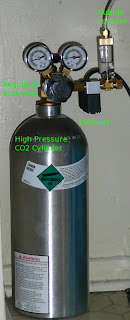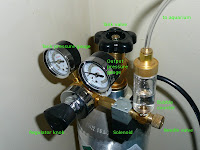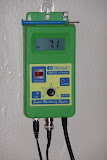Following are the specs I have found worth looking for when choosing a biological microscope for serious hobby. This is a summary of what I gathered reading about this on the net, and many explanations have been left out for brevity. I do not address the question of buying used or new, specs only.
HeadA trinocular head has binocular eyepieces (less strain on the eyes, better view) and a center port for a camera. Must be
parfocal so the image remains in focus when switching between camera and eyepieces. You might also need one with diopter correction.
Couldn't find much about different head types, but it appears one of the better ones is the
Siedentopf head where eyepieces rotate to adjust distance, as opposed to a slider type. Check interpupillary distance specs to make sure it works for you. Vertical angle is 30 degrees which is more comfortable than the 45 some have.
Ergo is a more advanced type allowing vertical angle adjustment (such as in the Meiji TL5000) but is not found in any affordable scopes yet.
There are two basic camera adapter types: C-mount for digicams and T-mount (42mm) for SLRs. Can't tell much except that you will need adapters on top of those, optical if you're unlucky.
EyepiecesYou want
10x eyepieces,
Wide Field or
Super Wide Field (18, 20 or 22mm). For reference, the standard 10x have 13mm field of view. Do not bother with 16x or 20x eyepieces, they provide "empty magnification*". Imagine a slide projector, you can make the image bigger but not more detailed. The objective provides the detail, the eyepiece just magnifies it.
*) According to Micrographia, higher-power eyepieces can still provide useful magnification for high NA objectives and are also good for people of lower visual acuity. A rule of thumb is that the maximum achieveable magnification is about 1000 times the NA of the objective, so objectives in a perfectly configured optical system are capable of more detail than seen with a 10x eyepiece. [note added Feb 8, 2009].
High-eyepoint eyepieces allow viewing from a more comfortable distance, and are good for eyeglass-wearers (they are sometimes marked with an eyeglass symbol).
NosepieceThe nosepiece is where the objectives are screwed into. You want a
reversed nosepiece (facing the back) so the objectives aren't in the way while working on the stage and are safe from smudging. Should have room for 4 or
5 objectives, the more the better because you have more objectives to use at once without having to unscrew and replace some. Other features to look for are ball bearing, positive click stops, knurled ring.
ObjectivesThe
objective is the most important part, because its NA (Numerical Aperture) is a critical factor in the final resolution of the image. These are the common types:
- achromats are the standard achromatic objectives;
- semi-plan (or so-called "flat field") provide a flatter field of view but how flat is usually unspecified;
- Plan achromats keep the focus plane in the entire image, usually twice the price of regular achros;
- apochromats are best but very expensive.
You want
Plan. Objectives must match the MTL, see below. Common sizes are 4x, 10x, 20x, 40xr, 100xr (requires oil). 60xr is less common but provides highest dry resolution (NA 0.85+). The "r" marking means "retractable" or "spring", it is found in the higher-power objectives so they do not cause damage when they bump into slides accidentally, as their working distance is fractions of a millimeter. Objectives with NA around 1 and higher require a higher refraction index medium, such as oil or water, between them and the slide. The rest that don't are called "dry".
Unless you're buying into a particular vendor, you want standard DIN objectives. This refers to the mounting thread specs. Also you want the set to be parfocal, the usual parfocal distance is 45mm. This is the distance from the base of the objective to the slide when the image is in focus. Parfocality allows switching from objective to objective without losing focus.
Some objectives are antifungal treated.
StageYou want a (large)
mechanical stage (the stage moves not the head) with more ergonomic
coaxial fine and coarse
focus, tension adjustment to avoid creep and a stage stop to prevent the stage from running into the objectives. Low horizontal x/y stage movement knob and vernier scales for noting position. Anti-scratch coating is needed (ceramic coating is best but rare).
All-metal gears are better than plastic especially for continuous use or long-term ownership prospects, but few mention this in their specs.
IlluminationAn "
Abbe" condenser of NA 1.25 is the basic type. Swing-out type allows insertion/removal of one lens to cover more field at 4x. An
Achro (achromatic, aplanatic) condenser with NA 0.7-0.8 is better for dry objectives but harder to find.
Köhler/Koehler illumination includes a field diaphragm and centerable light source to provide uniform lighting for best results. This is usually found in higher-end scopes. If it has Köhler, it probably has most of the features on this page.
Standard light is a 20W halogen with variable brightness. Others have LED. No standard (tungsten) incandescent (too hot and not enough light).
Phase Contrast
Many specimens are almost transparent thus difficult to see in brightfield without careful staining.
Phase Contrast is a technique that provides much better contrast and allows viewing even of transparent specimens. Most microscopes today are modular so adding Phase Contrast should be a matter of getting the necessary kit.
There are two options as far as component set. The
Zernike Turret Phase kit, which adds $600+ to the price, comes with a turret-style condenser.
Simple phase using slide-in filters is cheaper but not as easy to use as you have to swap filters when changing powers. Both use special Phase objectives, inscribed "PH" or "Phase" with standard 10x, 20x, 40x and 100x magnifications. Phase objectives can also be used for regular brightfield work, but brightfield objectives do not work for phase.
The
Zernike Phase turret has six slots named BF (BrightField), DF (DarkField), PH1, PH2, PH3, PH4 and comes with a dedicated Phase condenser. The PH slots are one for each objective because the annulus (circular) filters in the turret and the objective are part of the phase optical system and must match.
Other relatively accessible methods for improving contrast that I learned of:
- Dark field. Dry is not that useful. Oil dark field is much better, but messy and still not better than phase;
- DIC (differential interference contrast) produces an "embossed" image with great contrast, but is rather expensive
- Polarization. This can be done with a couple polarizer filters but I do not know what kind of image it produces. Dedicated polarizer scopes have a different, circular and rotatable, stage.
MTLThe optical system of a microscope is built around a certain MTL (Mechanical Tube Length) which is where the objective projects the virtual image. New objectives and eyepieces need to have the same MTL for best results. So keep that in mind when choosing the microscope.
- 160mm MTL I found is most common - buy that.
- 170mm is also found in some scopes.
- "Infinity-corrected optics" (marked ∞) is the latest tech, these allow adding other elements in the optical path without introducing aberrations. It is said however that you cannot mix and match eyepieces and objectives from different vendors due to a lack of standardization.
Useful resources










